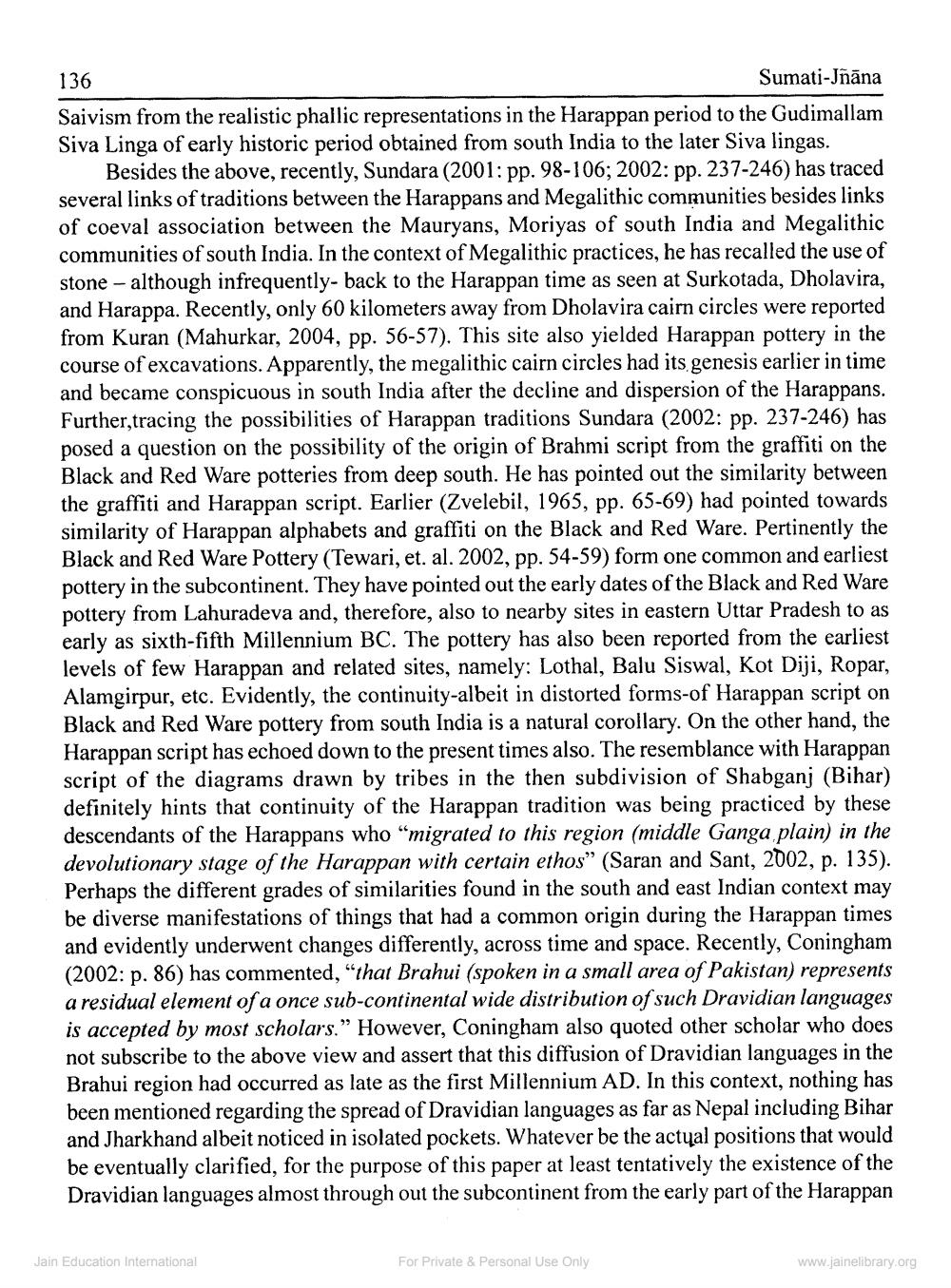________________
136
Sumati-Jñāna Saivism from the realistic phallic representations in the Harappan period to the Gudimallam Siva Linga of early historic period obtained from south India to the later Siva lingas.
Besides the above, recently, Sundara (2001: pp. 98-106; 2002: pp. 237-246) has traced several links of traditions between the Harappans and Megalithic communities besides links of coeval association between the Mauryans, Moriyas of south India and Megalithic communities of south India. In the context of Megalithic practices, he has recalled the use of stone - although infrequently-back to the Harappan time as seen at Surkotada, Dholavira, and Harappa. Recently, only 60 kilometers away from Dholavira cairn circles were reported from Kuran (Mahurkar, 2004, pp. 56-57). This site also yielded Harappan pottery in the course of excavations. Apparently, the megalithic cairn circles had its genesis earlier in time and became conspicuous in south India after the decline and dispersion of the Harappans. Further, tracing the possibilities of Harappan traditions Sundara (2002: pp. 237-246) has posed a question on the possibility of the origin of Brahmi script from the graffiti on the Black and Red Ware potteries from deep south. He has pointed out the similarity between the graffiti and Harappan script. Earlier (Zvelebil, 1965, pp. 65-69) had pointed towards similarity of Harappan alphabets and graffiti on the Black and Red Ware. Pertinently the Black and Red Ware Pottery (Tewari, et. al. 2002, pp. 54-59) form one common and earliest pottery in the subcontinent. They have pointed out the early dates of the Black and Red Ware pottery from Lahuradeva and, therefore, also to nearby sites in eastern Uttar Pradesh to as early as sixth-fifth Millennium BC. The pottery has also been reported from the earliest levels of few Harappan and related sites, namely: Lothal, Balu Siswal, Kot Diji, Ropar, Alamgirpur, etc. Evidently, the continuity-albeit in distorted forms-of Harappan script on Black and Red Ware pottery from south India is a natural corollary. On the other hand, the Harappan script has echoed down to the present times also. The resemblance with Harappan script of the diagrams drawn by tribes in the then subdivision of Shabganj (Bihar) definitely hints that continuity of the Harappan tradition was being practiced by these descendants of the Harappans who "migrated to this region (middle Ganga plain) in the devolutionary stage of the Harappan with certain ethos” (Saran and Sant, 2002, p. 135). Perhaps the different grades of similarities found in the south and east Indian context may be diverse manifestations of things that had a common origin during the Harappan times and evidently underwent changes differently, across time and space. Recently, Coningham (2002:p. 86) has commented, “that Brahui (spoken in a small area of Pakistan) represents a residual element of a once sub-continental wide distribution of such Dravidian languages is accepted by most scholars.” However, Coningham also quoted other scholar who does not subscribe to the above view and assert that this diffusion of Dravidian languages in the Brahui region had occurred as late as the first Millennium AD. In this context, nothing has been mentioned regarding the spread of Dravidian languages as far as Nepal including Bihar and Jharkhand albeit noticed in isolated pockets. Whatever be the actual positions that would be eventually clarified, for the purpose of this paper at least tentatively the existence of the Dravidian languages almost through out the subcontinent from the early part of the Harappan
Jain Education International
For Private & Personal Use Only
www.jainelibrary.org




